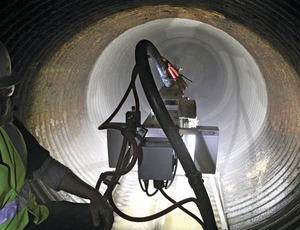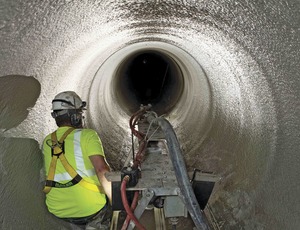

An ultra-dense geopolymer mortar product is gaining traction as a trenchless pipeline repair remedy among cash-strapped municipalities, partly thanks to a recent Environmental Protection Agency vetting. U.S. wastewater and stormwater infrastructure requires $298 billion in upgrades over the next two decades, with pipelines accounting for 75% of total needs, reports the American Society of Civil Engineers. EcoCast is one cast-in-place pipeline (CIPP) solution, up to 60% faster and 50% cheaper than traditional dig-and-replace approaches, the manufacturer claims.
EcoCast describes the exclusive application process of a microfiber-reinforced cementious material made with fly-ash, called GeoSpray and first developed nearly a decade ago by GeoTree Technologies Inc. In 2012, the firm sold it to Milliken & Co., which made further material improvements. At present, GeoSpray is produced exclusively for Inland Pipe Rehabilitation, a Houston-based trenchless rehabilitation contractor that created EcoCast's proprietary spray and 5,000-rpm oscillating "spincast" application method. The firm would not divulge sales figures.
"We spent two years perfecting the application process, while Milliken, our development partner, refined the GeoSpray material," says IPR President Joe Cutillo. "When it comes to introducing new sewer rehabilitation technologies, there is really no margin for error."
EcoCast recently proved its effectiveness in an EPA field demonstration for emerging pipeline-rehabilitation technologies. The product was used last year on a 60-in.-dia, 165-ft-long section of crumbling reinforced-concrete sewer pipeline in Houston. The results, released in Orlando in April during the North American Society for Trenchless Technology's "No Dig" show, revealed a chemically fused nano-ceramic bond with no cracking, infiltration or shrinkage. Ariamalar Selvakumar, an EPA engineer, described the product as "a technically viable structural alternative to traditional repair and replacement methods."
The patented product already has been approved by 35 state transportation departments, partly due to an excellent 1,300-psi flexural strength that can withstand dynamic loads from vehicle traffic. EcoCast also requires a small footprint for application, thereby minimizing roadway disruptions and detours. The lining forms a crystalline structure that restores concrete, brick and corrugated-metal storm and sewer pipes. It achieves better cost efficiencies with large-diameter pipeline, ranging from 30 in. to 200 in. The material can be layered up to 3 in. thick, with initial curing after two hours.
GeoSpray's manufacturer claims the material adheres to most clean surfaces—wet or dry and regardless of shape or bends—and meets ASTM, AASHTO and LEED standards. Boasting a 50-year life cycle, the 100% manufactured product reaches an 8,000-psi compressive strength after 28 days. Milliken offers a replacement warranty for defective material.
"Unlike shotcrete, EcoCast application has better bonding with zero rebound," explains Steve Henning, IPR technical director. "It can also be pumped over long distances, up to 500 ft, and applied in extreme temperatures due to the geopolymer composition."
EcoCast joins a small but growing family of CIPP repair methods that are minimally invasive, less costly and faster than full pipe replacements. Inliner, for example, can impregnate a deteriorating pipeline with a thermosetting resin cured by heated water or air for a seamless, jointless "pipe within a pipe." EcoCast is a unique niche solution for large-bore pipelines, but it's unlikely to revolutionize the industry, says one competitor.



Post a comment to this article
Report Abusive Comment